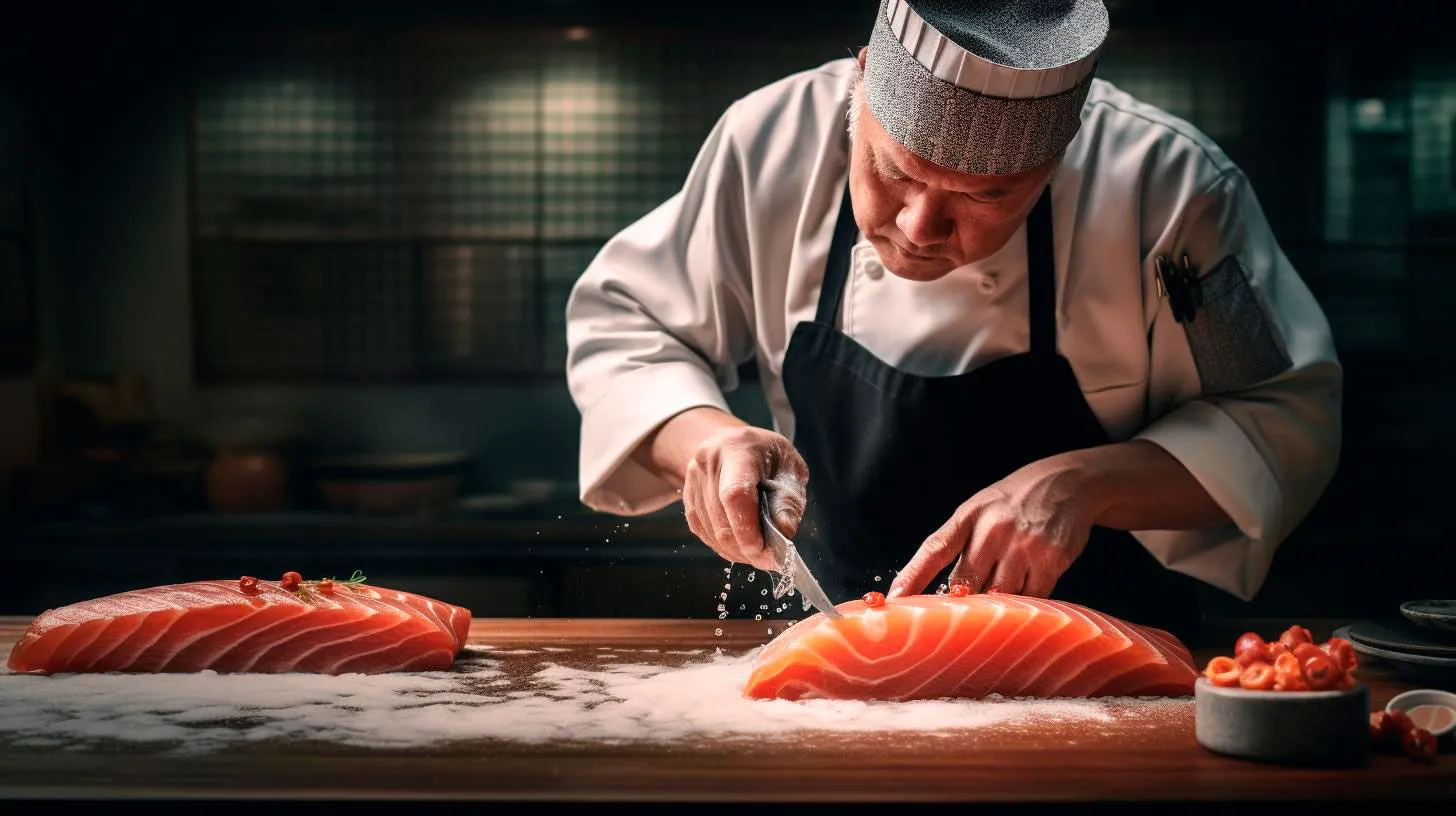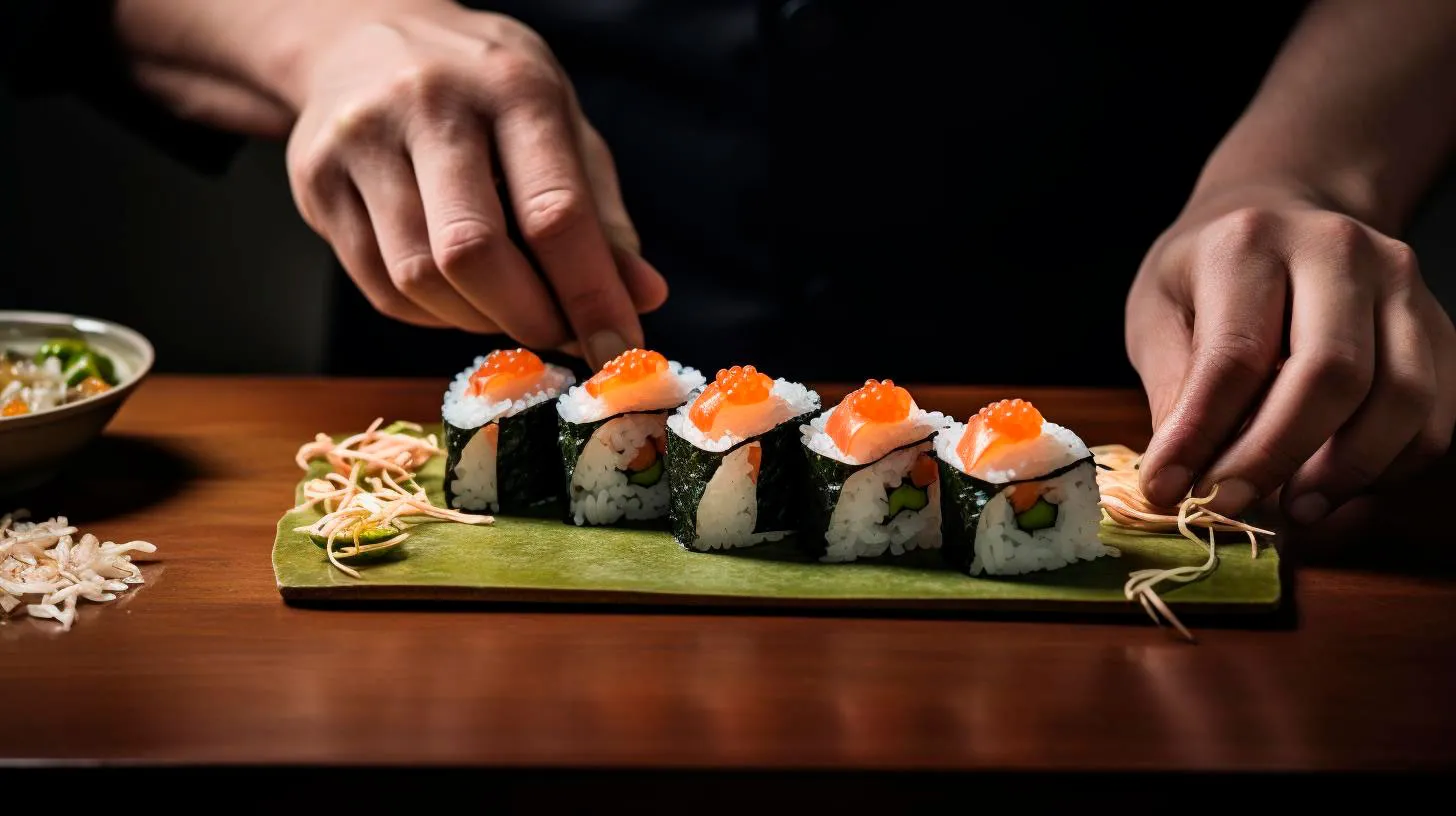Unveiling the Art of Sushi Making
In this article, we will delve into the secrets of sushi making, exploring the techniques, ingredients, and culture behind this culinary artform.
The Essence of Sushi
Sushi, which translates to “vinegar rice,” is the heart and soul of every sushi dish. This unique type of rice is seasoned with vinegar, giving it a tangy yet delicate flavor. However, sushi is not just about rice; it is a harmonious balance of flavors, textures, and colors. The key ingredients of sushi include:
- Sashimi: Fresh slices of raw fish or seafood
- Nori: Edible seaweed used to wrap sushi rolls
- Wasabi: Spicy green paste made from Japanese horseradish
- Gari: Pickled ginger served as a palate cleanser
- Soy Sauce: A salty condiment used for dipping sushi
These ingredients, combined with the artful presentation and meticulous preparation, create a sensory experience like no other. Let’s explore the key elements that make sushi making truly special.
The Technique Behind the Art
Making sushi is not just about assembling ingredients; it requires skilled craftsmanship and utmost precision. Here are some essential techniques used in sushi making:
1. Sushi Rice Preparation
The foundation of any great sushi dish lies in the preparation of the rice. The rice grains must be cooked to perfection—neither too soft nor too firm. Once cooked, the rice is seasoned with a mixture of rice vinegar, sugar, and salt. This simple yet crucial step enhances the flavor and texture of the rice, setting the stage for a fantastic sushi experience.
2. Nigiri-Maki Techniques
There are various sushi types, with the most common being nigiri and maki. Nigiri sushi consists of a hand-formed mound of rice topped with a slice of fresh fish or seafood. Maki sushi, on the other hand, involves rolling the rice and fillings in a sheet of nori using a bamboo mat. Mastering these techniques requires practice and patience.
3. Knife Skills
A sushi chef’s knife skills are paramount to the art of sushi making. The chef must precisely slice the ingredients, ensuring uniformity in shape and size. This meticulous attention to detail not only improves the dish’s appearance but also affects the overall taste and texture.
The Culture & Etiquette of Sushi
Beyond the technique and ingredients, sushi carries a rich cultural heritage and specific etiquette that adds to its allure. Here are some insights into the culture of sushi:
1. Omakase Dining Experience
Omakase, meaning “I’ll leave it up to you,” is a dining style where guests trust the chef’s selection. In traditional sushi bars, customers sit in front of the chef’s counter, allowing them to witness the artistry firsthand. The chef curates a personalized dining experience, showcasing the freshest and most exquisite ingredients.
2. Respect for Ingredients
Japanese cuisine focuses heavily on respecting the ingredients and their natural flavors. Sushi chefs prioritize using the freshest, high-quality ingredients, often sourced locally. This reverence for the ingredients enhances the taste and elevates the overall dining experience.
3. Proper Sushi Etiquette
When enjoying sushi, it is essential to observe proper sushi etiquette. Some key points to remember include:
- Using chopsticks or your hands: Depending on the type of sushi, it is acceptable to use chopsticks or your hands. Nigiri sushi is usually eaten with hands, while maki rolls are consumed using chopsticks.
- Avoiding excessive soy sauce: Use soy sauce sparingly to avoid overpowering the delicate flavors of sushi. Tread lightly and savor each bite.
- Not mixing wasabi with soy sauce: Contrary to popular belief, it is considered impolite to mix wasabi into the soy sauce. Instead, apply a small amount of wasabi directly to the sushi if desired.
The Rise of Sushi Worldwide
Sushi’s popularity has soared across the globe, transcending cultural boundaries. Here are some fascinating statistics about its global presence:
- The global sushi market is projected to reach $25 billion by 2023, growing at a CAGR of 3.5%. (Source: Market Research Future)
- As of 2020, the United States has approximately 4,260 sushi restaurants, making it the country with the highest number of sushi establishments outside of Japan. (Source: Statista)
- California rolls, a type of maki sushi, account for nearly 75% of all sushi consumed in the United States. (Source: Thrillist)
Key Takeaways
As we journeyed into the art of sushi making, we discovered that sushi encompasses technique, precision, culture, and respect for ingredients. Here are the key takeaways:
- Sushi is a balanced harmony of flavors, textures, and colors.
- Mastering sushi techniques, such as rice preparation and knife skills, requires practice and patience.
- The cultural aspects and etiquette surrounding sushi enhance the dining experience.
- Sushi’s global popularity continues to rise, with the United States leading the way.
Whether you’re a sushi enthusiast or a curious food lover, exploring the art of sushi making is a fascinating journey that invites you to savor every bite. So, the next time you indulge in a plate of sushi, take a moment to appreciate the craftsmanship and centuries-old tradition that goes into creating this culinary masterpiece.
Explore the Complex Flavors of Sushi
So grab your chopsticks and let’s embark on this culinary journey together!
A Brief History of Sushi
Sushi dates back to ancient Japan, where it initially began as a method of preserving fish by fermenting it with rice. This preservation technique allowed fishermen to store their catch for longer periods. Over time, sushi evolved, and during the Edo period, it transformed into the sushi we recognize today. The introduction of vinegar and soy sauce as ingredients led to the creation of exquisite and delicious sushi rolls.
Types of Sushi
There are various types of sushi, each offering a unique flavor profile and presentation:
- Nigiri: This classic and elegant type of sushi consists of a small mound of rice topped with a slice of fresh fish or seafood. Nigiri allows you to savor the natural flavors of the fish while enjoying the subtle taste of seasoned rice.
- Sashimi: Unlike other types of sushi, sashimi does not include rice. It comprises thin slices of raw fish or seafood that are served alone. The freshness and quality of the seafood are paramount in sashimi, allowing the flavors to shine without any distractions.
- Maki: Maki, or sushi rolls, are a popular choice for many sushi enthusiasts. They consist of seaweed (nori) wrapped around a combination of rice, seafood, vegetables, and sometimes sauces. The ingredients are then rolled tightly and sliced into bite-sized pieces.
- Temaki: Temaki refers to hand rolls, where a sheet of nori is filled with rice, seafood, and vegetables, rolled into a cone shape. It’s a fun and interactive way to enjoy sushi, offering a delightful mix of flavors and textures.
- Chirashi: Chirashi sushi is a colorful and vibrant bowl of sushi rice topped with an assortment of sashimi, vegetables, and sometimes additional toppings like tamago (sweet omelet) or tobiko (flying fish roe). It provides a visually stunning and flavorful experience.
Key Factors that Shape Sushi’s Flavor
Several factors contribute to the distinctive flavors of sushi:
- Rice: The type of rice used in sushi plays a vital role in its overall flavor. Short-grain sushi rice is known for its stickiness and slight sweetness, which complements the fish and other ingredients.
- Fish and Seafood: The freshness and quality of the fish are of utmost importance in sushi. The taste, texture, and aroma of the fish contribute significantly to the overall flavor profile.
- Wasabi: Wasabi, a pungent green paste made from the Japanese horseradish root, adds a sharp and refreshing flavor to sushi. It provides the perfect balance to the fatty and rich taste of certain fish.
- Soy Sauce: Soy sauce, when used sparingly, enhances the flavors of sushi. The saltiness of soy sauce complements the delicate flavors of the fish and rice.
- Pickled Ginger: Pickled ginger acts as a palate cleanser, refreshing the taste buds between different sushi pieces. Its mildly sweet and tangy flavor helps reset the palate for the next bite.
The Advantages of Eating Sushi
In addition to its excellent taste and artistic presentation, sushi offers several advantages:
- Health Benefits: Sushi is generally considered a healthy option since it is packed with lean proteins, omega-3 fatty acids, and essential nutrients. It is also low in calories and fat, making it an ideal choice for those looking for a nutritious meal.
- Variety and Customization: Sushi offers an incredible variety of flavors, whether you prefer raw fish, vegetarian options, or cooked seafood. With customization options like adding spicy mayo or avocado, you can tailor your sushi experience to your taste.
- Social and Cultural Experience: Sushi dining is often a social event, perfect for sharing plates and experiencing different flavors with friends and family. It also allows you to immerse yourself in the rich Japanese culture and culinary traditions.
Key Takeaways
Sushi is a culinary delight that continues to captivate food lovers around the globe. From its humble origins as a preservation method to its current status as a global sensation, sushi remains a testament to the skill and creativity of Japanese cuisine. Remember these key takeaways:
- There are various types of sushi, including nigiri, sashimi, maki, temaki, and chirashi.
- The distinct flavors of sushi are shaped by factors such as the type of rice, freshness of fish, and accompaniments like wasabi and soy sauce.
- Sushi offers numerous advantages, including health benefits, customization options, and a social dining experience.
So, the next time you sit down for a sushi feast, take a moment to appreciate the intricate flavors and cultural significance behind each bite. Sushi truly is a culinary experience like no other!
Immerse Yourself in the Sushi Culture at a Class
If you’ve ever wanted to learn the secrets behind creating these beautiful and delicious bites, consider immersing yourself in the sushi culture at a sushi-making class.
Discover the Fascinating History of Sushi
Before delving into the practical aspects of sushi-making, it’s essential to understand its rich history. Sushi originated in Southeast Asia around the 4th century BC as a preservation technique. Fish and rice were fermented together, creating a unique flavor. This method eventually made its way to Japan, where it evolved into the sushi we know and love today. By joining a sushi-making class, you’ll gain insights into the origins of this culinary art form and its cultural significance.
Learn from Skilled Sushi Chefs
Attending a sushi-making class provides you with the opportunity to learn from skilled and experienced sushi chefs. These experts have spent years honing their craft and perfecting the art of sushi preparation. They possess a wealth of knowledge about choosing the best ingredients, handling fish, and creating visually stunning presentations. By participating in a class, you can absorb their wisdom and refine your sushi-making skills.
Key Takeaway: Learning from experienced sushi chefs allows you to gain valuable insights and techniques that can elevate your sushi-making abilities.
Master the Art of Creating Perfect Sushi Rice
While many people focus on the fish when they think of sushi, the rice is equally important. The perfect sushi rice is sticky, slightly sweet, and has the right balance of vinegar seasoning. Sushi-making classes offer an in-depth exploration of the art of sushi rice preparation. You’ll learn about the proper cooking techniques, the importance of rice quality, and the seasoning process that brings out its distinctive taste. Mastering sushi rice preparation is essential to creating authentic and delicious sushi.
Key Takeaway: Perfecting the art of making sushi rice is crucial to achieving the desired texture and flavor of your sushi rolls.
Explore Different Sushi Styles
Sushi is much more than just the popular raw fish rolls that are commonly associated with it. Sushi-making classes introduce you to a wide variety of sushi styles beyond the well-known California rolls and nigiri. You’ll discover unique creations and regional variations, such as chirashi (scattered sushi) or temaki (hand rolls). Exploring these diverse styles allows you to expand your sushi repertoire and appreciate the versatility of this beloved cuisine.
Key Takeaway: Diversifying your sushi knowledge by exploring different styles opens up a world of exciting flavors and presentations.
Enhance Your Knife Skills
A fundamental aspect of sushi preparation is knife skills. From slicing fish to crafting meticulous cuts for presentation, the precision of your knife skills greatly impacts the final outcome of your sushi creations. Sushi-making classes offer invaluable guidance on proper knife selection, sharpening techniques, and cutting methods. You’ll learn how to handle a sushi knife like a pro, ensuring your sushi looks as visually appealing as it tastes.
Key Takeaway: Mastering knife skills is essential for creating beautifully crafted sushi and enhancing the overall dining experience.
Immerse Yourself in the Sushi Culture
Attending a sushi-making class goes beyond learning the technical aspects of sushi preparation. It allows you to immerse yourself in the captivating sushi culture. Through hands-on experiences, you’ll develop a deeper understanding and appreciation for the meticulousness and precision required to create this iconic culinary delight. You’ll also gain insights into Japanese dining customs, the significance of presentation, and the philosophy behind each aspect of sushi-making.
Key Takeaway: Joining a sushi-making class provides an immersive experience into the rich culture and traditions associated with this revered culinary art form.
Conclusion
Participating in a sushi-making class is more than just learning how to roll sushi. It’s an opportunity to embark on a cultural journey, discover the origins and techniques of sushi-making, and expand your culinary horizons. By learning from skilled sushi chefs, mastering the art of sushi rice, exploring diverse sushi styles, refining your knife skills, and immersing yourself in the sushi culture, you’ll be well on your way to creating impressive sushi creations that will impress both your taste buds and your friends.
Master the Techniques of Hand-Rolling Sushi
The Art of Hand-Rolling Sushi
Sushi rolls, also known as maki rolls, are a popular type of sushi that consists of various ingredients wrapped in a sheet of seaweed, known as nori, and sticky sushi rice. Hand-rolling sushi is an essential skill for anyone interested in Japanese cuisine, and with a little practice, you can create restaurant-quality rolls right in the comfort of your own kitchen.
Key Takeaways:
- Hand-rolling sushi is a great way to explore your creativity in the kitchen.
- With practice, you can achieve perfect sushi rolls that are as good as those served in restaurants.
- Mastering hand-rolling sushi allows you to customize your rolls with your favorite ingredients.
- It’s a fun and interactive activity to share with friends and family.
Mastering the Techniques
To master the art of hand-rolling sushi, you need to learn the fundamental techniques involved. Here are the steps you should follow:
- Prepare the ingredients: Gather your preferred sushi fillings such as fresh fish, vegetables, and sauces. Ensure they are sliced into thin, uniform pieces.
- Prepare the sushi rice: Wash your sushi rice thoroughly and cook it according to package instructions. Once cooked, season the rice with a mixture of rice vinegar, sugar, and salt.
- Layout your sushi mat: Place a bamboo sushi mat on a clean surface and cover it with a sheet of plastic wrap. This will prevent the rice from sticking to the mat.
- Place the nori on the mat: Lay a sheet of nori on top of the sushi mat.
- Spread the rice: Wet your hands with water and grab a handful of sushi rice. Gently spread it over the nori, leaving a small border at the top.
- Add fillings: Arrange your preferred fillings over the rice. Be creative and experiment with different combinations of flavors and textures.
- Rolling the sushi: Start rolling the sushi by tightly grasping the bamboo mat and folding it over the filling. Apply gentle pressure and continue rolling until the entire sushi roll is formed.
- Sealing the roll: Wet your fingertips with water and moisten the exposed nori at the top. This will help seal the roll.
- Cutting the roll: Use a sharp, wet knife to slice the roll into bite-sized pieces. Remember to clean the knife between each cut to ensure clean slices.
Key Takeaways:
- Preparing the ingredients and sushi rice is essential for successful hand-rolling.
- The bamboo sushi mat and plastic wrap prevent the rice from sticking and make rolling easier.
- Be creative with your fillings to customize your sushi rolls.
- Moistening the nori helps to seal the roll and prevent it from falling apart.
Advantages of Hand-Rolling Sushi at Home
Hand-rolling sushi at home provides numerous advantages. Let’s explore some of them:
- Cost-effective: Making sushi at home is more economical than dining out at a sushi restaurant.
- Healthier choices: By choosing your own ingredients, you have control over the quality and freshness of the sushi components.
- Creative freedom: Hand-rolling sushi allows you to experiment with different combinations of fillings, sauces, and toppings to suit your preferences.
- Entertaining guests: Hand-rolling sushi can be a fun and interactive activity to share with friends and family. Host a sushi party and let everyone customize their own rolls!
Key Takeaways:
- Hand-rolling sushi at home saves money and allows for healthier options.
- Get creative and explore different flavor combinations.
- Hosting a sushi party is a fun way to engage with friends and family.
Now that you have learned the techniques of hand-rolling sushi, it’s time to roll up your sleeves and start practicing. With a bit of patience and creativity, you’ll soon be impressing everyone with your homemade sushi rolls. So, gather your ingredients, master the art of hand-rolling sushi, and enjoy the satisfaction of creating your own delicious sushi masterpieces!



